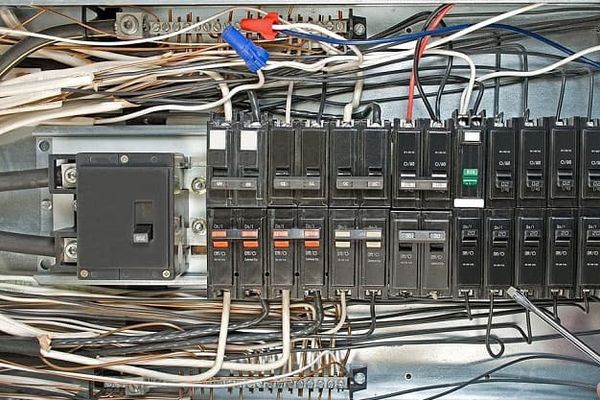
Are T&B Breakers Compatible With Siemens? Compatibility Guide
We are going to say this upfront. When it comes to circuit breakers, it is okay to go out and buy new ones BUT if you do not like working with electricity or are not properly trained to change circuit breakers, hire a professional to do the work. Play it safe when around electricity
Yes, there are models of T & B circuit breakers that are compatible. The best way to find out which ones that are, just read the circuit breaker panel. It should tell you what ones you can use if the wording has not faded over time.
To learn more about this topic, just continue to read our article. It explores the subject so you have the best information possible. Part of that information is that most manufacturers make their own designs so you are forced to buy their breakers only.
What Replaces a T&B Beaker?

There are several circuit breaker makers in the country but not all are compatible with each other. Each manufacturer makes its own style of breaker and panel box and often tweaks the designs to make sure only their breakers fit.
Then some of the companies that make circuit breakers bought out other companies which complicates the compatibility scene. We checked different lists and T & B is only mentioned on one out of a series of compatibility lists.
It is interchangeable with Eaton circuit breakers. However, there are 7 other companies on that list so T & B should be compatible with those 7 other companies. They may not be designed exactly the same but they are interchangeable.
Why T & B is not mentioned on the other lists showing compatibility is not known as we have checked a second chart which shows a lot of compatibility with different brands.
Here is the link to the second set of lists that we checked. It will help you find different brands you can work with if your area stores are not selling your brand.
At that link, you will notice they mention just about every company and list those competitors that work together except for T & B which is Thomas & Betts.
T&B Breaker Compatibility
Here is a chart to help you find compatible circuit breakers if you are replacing T & B breakers or want to use T & B breakers in your breaker panel.

If the chart is not readable or cannot be enlarged, just click this link to see the information. If you are not sure, take the chart to a professional electrician and let them help you understand how the compatibility works between brands.
Are T&B Breakers Compatible With Siemens?

The logic goes that if the two companies are compatible with a 3rd, 4th or even 5th company’s design, then the first two companies should be compatible with each other
That would mean that T & B would be compatible with Siemens. But there is more to the story than just matching up breakers. It is said that the only legal way to change breaker brands is if the alternative brands are listed on the panel’s cover.
Sometimes T & B are written TB so if TB is on the panel and those letters refer to T & B, then you can use T & B breakers in that panel. It can get confusing as there are always a bunch of letters and numbers on electrical breakers and the panels they are placed.
Also, not every store will carry every brand. You will need to do a little searching to see which hardware or big box store has what brands. Your best bet would be to go to an electrical outlet to get the needed brand. Not every electrical store is large enough to carry a wide selection of breakers.
Finding a T&B Breaker Replacement

Eaton is going to be your best bet but check your T & B panel to see which breakers would work instead of the T & B brand. The best way to find a replacement for this brand of breaker is to remove it and then take it to an electronics store or a big box home center.
The clerks should be able to help you find the right replacement. Or you can use the chart above to see what other brands could replace the T & B breaker. The problem you will run into is that while newer T & B products are interchangeable with other brands, the older T & B breakers were not.
You would have to find out how old the breakers are in your home before you can find compatible replacements. The chart above should help you get started on your search in the right direction.
How do You Know If a Breaker is Compatible?

The first place to look would be on your circuit breaker panel. There should be a long sheet listing all sorts of information about the panel, what breakers should be used as well as compatible brands.
They may be listed by initials only so you would have to be up on the different brand names. Then if the sheet on the panel has faded, you can try the first link above. It provides a compatibility chart for several of the brands.
Unfortunately, they do not list a chart for T & B. But matching the brand is just the beginning. You also have to match the voltage, the part number, and any other specifics that make sure you have the right breaker in the old one’s place.
To spare yourself some work, we suggest either talking to an experienced electrician to help you out or going to a dedicated electrical supply store to get your replacement.
The latter should have them in stock or knows a store nearby that does. The experienced electrician may simply direct you to one of those stores to get what you need.
Make sure to bring your old breaker with you so the store can match up the replacement exactly.
Specified, UL Classified / Interchangeable Circuit Breakers

There is some controversy over buying replacement breakers. Some companies will use those replacements as excuses to void any warranty over their electrical panel. They prefer that you use their brand of the breaker.
The term specified breaker simply means that a manufacturer has tested different companies’ breakers in their panels and found that they work well. Those specified brands are the approved replacements and they should be mentioned on the panel.
UL or interchangeable breakers are not tested by the brand making the electrical panel. They are made by other companies and tested by a third party. The third-party approves them for use in different electrical panels when found that they are similar to the manufacturer’s brand of breakers.
Those companies that do not like the third-party approved breakers in their panels cite the “National Electrical Code (NEC) Section 110-3(b), which states that using breakers not listed or labeled is a code violation.”
Other companies disagree with those that take that position and state that their breakers are NEC-compliant and meet all regulations. If you use aUL classified or interchangeable breaker in a specific brand’s panel, the latter cannot void its warranty.
What stops them from voiding the warranty is that the regulations state that if a third party proves the interchangeable breaker is safe in a breaker panel, then you can use that different breaker brand.
What To Look For When Replacing Breakers

1. Load capacity- the new breaker must be the same size as the old one you are replacing.
2. Model number- you will find this on the breaker or the panel and the manufacturer lists the different model numbers. If you find one from another brand with the same model number, then it should be able to be used instead.
3. brand- it is always best to replace the old breaker with the same brand that made it. This may not always be possible as brands are bought out, go out of business, or stop making those models.
Also, this information, including the model number, may have faded from readability and you may have to go to an electrician to get the same breaker.
4. Ask the pros- if you are still confused and it is a good possibility as so many modern companies have bought other breaker making companies, the pros will know what brand or model number you will need.
Some Final Words
There are many many different circuit breaking making companies in the country. You should be able to find interchangeable or replacement breakers with ease.
The bad news is, the older the breaker, the less likely you will find a non-brand replacement. The good news is that many of the older companies have been bought by other circuit breaker making companies and their products will fit the ones made by the company that was bought out.

